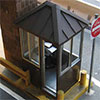
High-Tech Solutions
Reaching out to the perimeter to protect the first line of defense
Nearly everyone is familiar with the standard manned
guard booth in which a person sits and allows drivers
in and out of a facility; however, border stations,
government buildings, military bases and other locales
where there can be a “very unwanted guest” all use much highertech
security booths.
A High-Tech Security Booth
Bullet-resistant booths can be specified as Level 1, 2, 3 or 4, with 4
providing the highest level of resistance. These booths are tested and
certified to conform to Underwriters Laboratories standard UL 752
and others as required. If wanted, they are pre-wired to N.E.C. (i.e.
125 AMP, 120/240 Volt, 6/12 station, single phase or whatever current
is used in that region) and come fully assembled, ready for service.
Bullet-resistant, Level 4 booths currently protect the Pentagon in
Washington, D.C., but companies don’t have to be the Pentagon to
take advantage of the high security these booths have to offer. High
security booths are used for applications that range from the Ontario
Airport to Cairo embassies needing extra security.
For instance, 50 custom-designed, bullet-resistant guard booths
are now used at the San Ysidro Landed Port of Entry (SYLPOE), the
busiest land port in the world. Located between San Diego, Calif., and
Tijuana, Mexico, the port processes an average of 50,000 northbound
vehicles per day. The majority of the traffic lanes have two stacked,
bullet-resistant inspection booths created by Delta Scientific for
northbound traffic, effectively doubling the capacity of the 24 existing
booths.
These highly energy-efficient structures have a photovoltaic and
Ethylene Tetrafluoroethylene (ETFE) roof structure that will shade
cars and officers while providing rain and sun protection for officers
inside the booths. Because of its translucence, it allows for natural light,
thereby requiring no artificial lighting during the day.
Specifications for a High-Tech Booth
Typically, the specifications for a bullet-resistant, high-security booth
will include protection against impact:
- Level 1: handgun, 9mm or .357;
- Level 2: handgun, .44 magnum, 5.5 ammunition or 12g shotgun;
- Level 3: high-power rifle, such as a 30.06, 7.62 ammunition, hand
grenade and high explosive; and
- Level 4: All structural members meet or exceed ASTM A500, sliding
or swing door fabricated from structural steel with heavy duty
hardware for bullet resistance. All electrical components will be
UL approved and installed in accordance with the N.E.C.
Sometimes, the location of a booth itself creates a problem in delivery.
This was the case at the Metro in Washington, D.C. A custom
booth was required because the booths needed to be shipped in eight
pieces to the stations aboard Metro trains.
The Ultimate in High-Tech Guard Booths
The State Department is using bio-defense mail room inspection
BioBooths at several embassies throughout the world. BioBooths
feature outer and inner workrooms with sealed doors, lighting and
hospital-style floors. Each room has long countertops and open spaces
for staging, sorting and prospective decontamination. A bench,
top-mounted, HEPA-filtered, laboratory hood with UV sterilization
is pre-installed and may be flexibly positioned to isolate and protect
the inspector opening the packages. The booths have controllable
drainage and an internal wash-down hose bib. An optional sub-floor
basin catches contaminated liquid for removal through a valve into a
disposal container.
The BioBooth is typically installed outside of a main building or
inside a shipping-and-receiving warehouse. Upon discovering contaminated
mail, the BioBooth can be sealed, quickly unbolted and
safely removed from public areas for decontamination.
Self-contained, prefabricated, pre-wired and UL-listed, the Bio-
Booth mail screening booth allows inspectors to safely receive and
open mail, isolating the rest of the staff and facility from exposure, if
bio-hazards are delivered.
From bullets to bioterrorism and a host of other attacks, a guard
booth can be built so it will protect the guards, people and facilities
that they are there to defend.
This article originally appeared in the April 2014 issue of Security Today.
About the Author
Greg Hamm is the vice president of sales and marketing at Delta Scientific.